An Environmental Assessment Statement released by the NYC Department of City Planning reveals how proposals to rezone Manhattan’s SoHo and NoHo neighborhoods could permanently alter the area. The actions aim to expand allowable residential density for multifamily buildings, spur the construction of income-restricted and permanently affordable housing, and increase available community facilities. If approved, the upzone could spur the development of more than 3,200 new apartment units, 108,000 gross square feet of retail space, and 35,000 square feet of community facilities. Estimates for residential development include up to 940 affordable apartment units.
The proposed amendments would affect approximately 56 city blocks or 146 acres. This includes 11 blocks in NoHo and 45 blocks in SoHo. The formal review focuses specifically on how new construction and development will impact the neighborhood’s character, public health, air quality, infrastructure, and building shadows, as well as potential displacement of existing businesses, schools, and open space.
In 1971, when the area’s current zoning was adopted, the intention was to facilitate a path for existing working artists to legalize their live-work occupancy, while also preserving space for manufacturing and wholesale businesses. Since that time, the area’s existing zoning has become restrictive to the diversification of use types within the neighborhoods.
One example cited by the Department of City Planning is zoning rules that generally require ground floors to be occupied by light manufacturing tenants. Any other use types, such as office space, retail, or dining, require a special permit which typically requires storefronts to be kept vacant for long periods of time. The department asserts that a shift away from manufacturing in favor of retail, office, creative production, and other commercial uses is more consistent with economic conditions and land use trends in SoHo and NoHo.
The proposal is subject to review and approval under New York City’s Uniform Land Use Review Procedure. Most of these developments would also be subject to review and approval by the Landmarks Preservation Commission due to the affected areas’ location within the SoHo-Cast Iron, NoHo, and the NoHo East Historic Districts.
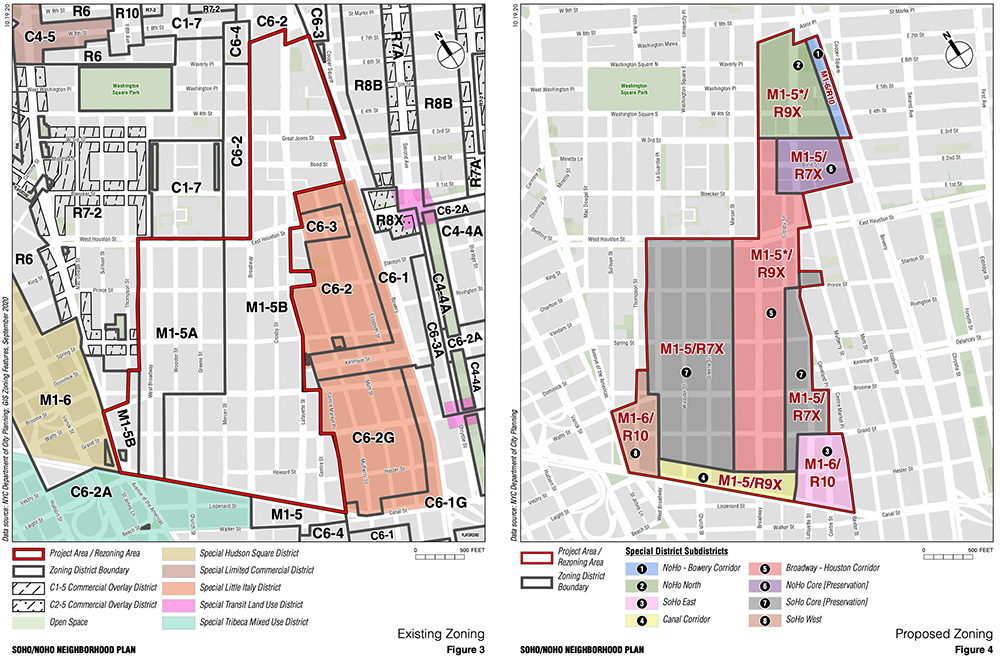
Existing (left) and proposed (right) zoning in SoHo and NoHo, Manhattan – NYC Department of City Planning
According the environmental assessment, the proposed actions would not result in major displacement of existing residents, community facilities, and services.
The actions would, however, directly displace more than 100 employees, which will require a secondary impact study. Additional adverse effects also include the construction of high-rise buildings with large shadows in “sunlight-sensitive” areas, vast in-ground disturbances that could affect nearby historic buildings or unearth hazardous materials, along with an increase in reliance in existing energy, water, and sewer infrastructure.
The forthcoming scope of work draft will provide further details on how the Department of City Planning might modify the proposed zoning amendments to curtail some or all of the adverse impacts.
Subscribe to YIMBY’s daily e-mail
Follow YIMBYgram for real-time photo updates
Like YIMBY on Facebook
Follow YIMBY’s Twitter for the latest in YIMBYnews

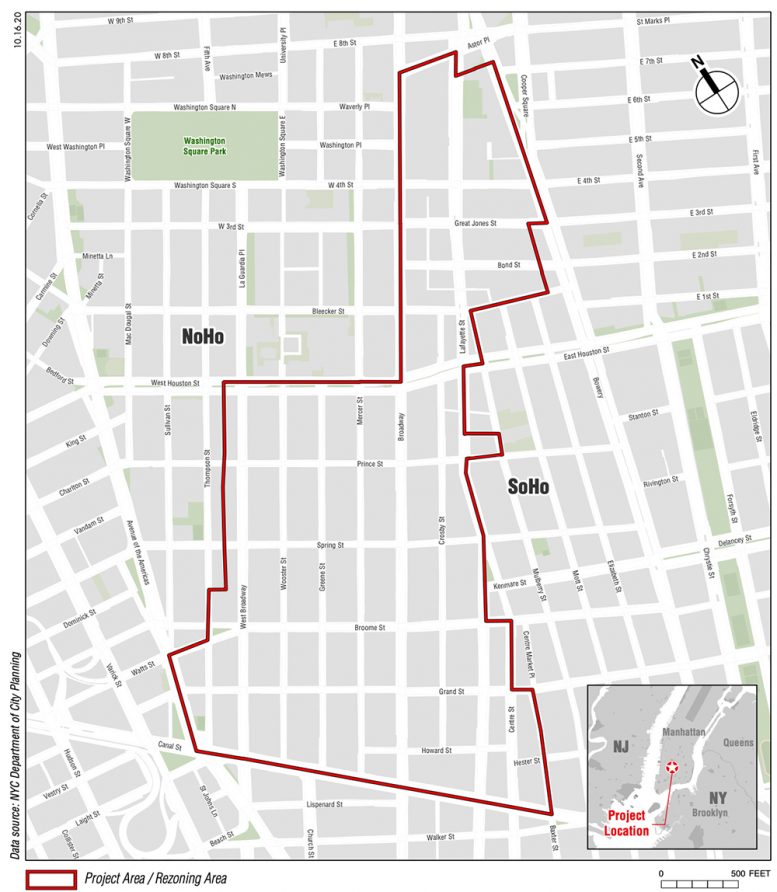
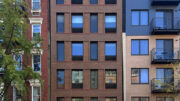

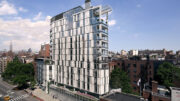
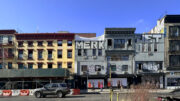
Fair enough.
Leave the area alone. Its one of the gems left in NYC!
I agree. A beautiful neighborhood. ‘Mixed income’ housing is designed to become low income housing with all of it’s related crime increases. The market rate tenants will be driven out by the behavior of the low income tenants. That is what this is all about.
Hell no, except for NYU, anything else should be limited at 12 floors, no high rises for homeless, no “high rise jails”, enough is enough for this mayor!!!
As soon as affordable or low income housing is mentioned some get in an uproar. Unit rents will be scaled to ami or other metric.
As for crime and what not? Most residnets in that area r qyite wealthly or recipients of old world shacks they modernized and rwnt out illegally.
The goal here is to gwt grandma jane or uncle fred to sell their rowhouse or brownstone for tidy sums and build chic overpriced residences opposite some couture shop.
Stop denigrating low income ppl. Noho and soho was low income at some pt. Full of druggies anf hipsters stradling the streets. The change came when some chic crowd realized they could get space at hood rates. And then it when uphill or downhill… Affordability morphed into flavorless chic brqnds driving cost up.
Its the same cycle. This time the city can play both sides. “Affordable” units fot 95k income 2 person studios. Or 115k for 4 person family. Which might be mifdle to lower income.
But consider the cost of food. Bars. Meat. Salons. It would be billionares row but with quaint 1920s brick buildings.
God bless u if there is a lone bodega or two an affordable 6 dollar sandwich. The bodega owner would have more financial gain selling their 3 story modest building for 3.2 million.
These owners r old folks and the city knows it will be a viable sellers market. Legacy tenants inthe community make north of 150k or 25k and live in rent stablized or controlled railroads or ancient constructs.
85 percent of nycers could afford a matket rate 1 Bedroom in that community. At 3800? 4500? 5100? Plus a 16 dollar martini or 180 dollar hair session?
But the revolving message is about riff raff and crime?
Except that’s not what mixed income mandatory inclusionary housing housing is. It mandates below market rate but most of it is what we’d consider middle income, 80 to 120 percent of the area median income of the metropolitan area. Have you seen some of the notices for “affordable” housing? 60G, 80G, 100G household incomes. And, to the extent that housing is set aside for low income and working class households, the surrounding neighborhood becomes unaffordable, for poor and working class households.
Where has mixed income housing become low income housing in the past 30 years? It happened to a lot of Mitchell-Lama housing, but that was in the 60s and 70s. Which 80/20 from the 90s? Which 421A? It just hasn’t happened in 40 years, whereas the opposite has happened in low income neighborhoods where mixed income developments have been built. Shopping for poor people is replaced by shopping for gentrifiers. The owners of unregulated housing, small buildings, realize that the neighborhood is changing and they can cash out or massively jack up the rent because the market will now pay it.
What we are doing to create and preserve housing that is affordable to all incomes is not working. And the city can’t function if the lowest paid people can’t live close enough to their jobs for it to be practical.
Ur pts r valid. But work and proximity r all relative. Lower wage workers r likely to live in the outer boros or in subsidized or legacy urban homes.
High earners r flocking to remote areas as well. But just that there has been a concerted matketing and transportation upgrwde to promote those fsr rewching hoods.
Think long island city. Washington heights. Red hook. Gowanus. South bronx. Bed stuy.
Those r all hoods that would have outliers but the economifs made it worthwhile for someone to buy homes there in 1995.2005.2015. Any of those hoods land would be quite more expensive now. So its all relative. And how diverse of a community u eant tolive in relative to race, income and perception.
On the other hand u have firefighters and cops who work in brownsville but will drive 10 20 30 40 or 80 miles a day to come to work. They reside in undiverse suburbs which afford space. Sprawl and bettet wchooling.
My pt is that those seeking affordability cannot look to legacy hoods. They must take on the mindset of the cops and firefighters and find some area that is close and can be had at relative prices.
Case example is mt vernon in westchester. Metro north is accessible. U fan get a 700k home vs a 600k studio.
Hoods only change when less poor ppl move into poorer hoods.
Really? Come on really?
Rezone Greenwich Villsge also. All old buildings with empty stores . Build 15 story buildings and build middle income housing .
Da village aint getting rezoned. Too much money to resist it. Alot of landmarked crap too. The visuals would be destroyed.
To many illegal or cash rentals taking place. For some the cost basis is made up for with room rentals at 1200 per. With 3 rooms x 3 floors? With the occupants being friends of friends or those with moola money dinero in hand. Not to mention the rent regulated old timers who will never leave? Thats why there r slumlord owners. Who wants a sweet old lady paying 460 dollars for a stuido or 1 bedroom ? Three blocks from tompkins.
These owners make bank off the hipster bar or boutique on the ground floor.
Plus property acquisition costs would be insane. A 4 story 8 unit building would cost north of 5 million. Plus consttucting it would be a mess.
Legacy owners r better keeping their homes. Some owners may splurge 50k fot a residing. Exterminate the floors and deliver a vacsnt apartment. The only amenity is a 2500 samsung fridge and a 2000 stove. Some chic lighting.
Badaboom studio for 4100. Or 2 bedroom for 6200. Remember their cost was sub 100k to “remodel” . with a heloc or loan they make that back sitting down. And the primary old school owner lives rent free in a bummy old studio. Its these 55 yr old overall wearing unshaved dudes that own buildings like those. Some inherited from pops or granny.
Then there is the slick hair suit who is scumbag landlord. Or then the middle ground ppl. All in all there is too much easy money and little need for legscy owners in the village.
to avoid destroying these areas you need to rezone with reasonable height limits. the problem comes when 15-25 story towers start popping up on a block of three story buildings.
is it so wrong to limit the heights to six or eight stories? that provides sufficient density without creating a rush to destroy everything older.
in truth, the real problem with new construction is the pathetic facades and designs relative to what was built before. every single person who lives here knows it and instead of fighting about that they fight over stupid things.
Your right. Alot of buuildings in the village dated to 1800s. And alot of them r pieces of crap with poor maintenance.but keep the brick facade and old world top hat appearances is best. Six story buildings might work. But its the cost of land that is the problem.
Some like u or friends may have bought an ev or wv shack for 1.5 or 3 million yrs ago. If so what was the cost of repiping. Insulation. Fireplace cleaning. Fkooring. Septiv. Boiler.
For some ppl the cost balances. 4 million total costs with upgrades circa 1990 2000 2010? But u get a 2500 to 3500 sq foot home for property taxes and mortage fees?
It all depends on ur cost basis. Newer six story buildings would have elegant decks and 15 foot glass. Elements that detract from the grit of that hood.
The histprical essence of poor writers, artists, boheminians, addicts, etc…. Evolved into white shoe lawyers who seek hot chicks and bars for 5400 a month?
As ive commented before 85 percent of nycerscould not afford market rate leases for east village cribs. Im confidant a sizeable portionof units r illegal subdivisions or couch surfing multi tenant residences.
What beenfit is there near term for living in the village? No clubs. Bars. The hot dudes and chicks r in brooklyn. The village is a den for old ppl and wanna be the next star on tv ppl.
Who are the geniuses making these decisions?
Manhattan is overbuilt, and then you’re going to increase the F.A.R?
While people are leaving Manhattan in thousands, you want to add additional SF?
Victor Weinberger
Realtor
One of the big problems in this neighborhood is that the housing in most SOHO buildings is technically illegal because it is artist lofts. Rezoning the area would potentially legalize the housing that is already there (and people pay a pretty penny for the technically illegal housing). I agree that we should not be tearing down the old commercial buildings (and we generally won’t because so many of them are in historic districts), but legalizing the housing might be useful.
Indeed many of these lofts r illegal. Not certain if there is cash under the table. Probably. But precluding, removing or adjusting these 19th century laws may increase building values. Or perhaps boot the old timer with a sweet long term lewse. There is no easy wnswer.
SoHo doesn’t need additional mid rise apartment buildings. This part of the city is a gem. one of the most unique peices of NY culture, and yet they want to rezone it into a more affordable housing project? I can’t believe what i’m hearing.
Billy boy? A housing Project? Ehat narrow hole do u live in? There has been a large housing project built for decades.
This is affordable housing based likely on area median income. Which is quite high relative to the average national income. Ur logic states that the average us income of 49k would be too high or low?
49k avg us worker income? In soho and noho? Thats the pjs? More like 79k or 119k? Thats the pjs?
Oh and least i remind u stuyversant town. Coop city. Parkchester gardens. Those were pjs too. Privately financed ones. With historically low yo moderate legacy rents.
Till private quity bought stuy town and has raised its rates.